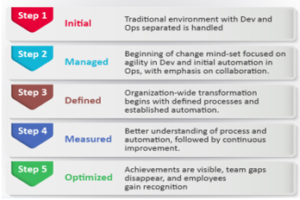Introduction
DevOps maturity reflects an organization’s progress in adopting and optimizing DevOps practices. As businesses increasingly seek to enhance software delivery and operations, understanding the stages of DevOps maturity becomes crucial. Therefore, aspiring professionals are suggested to join the DevOps Training program for the best skill development. These stages outline a journey from basic, ad hoc practices to fully integrated, automated, and innovative processes. By progressing through these phases, organizations can achieve greater efficiency, collaboration, and continuous improvement in their software development lifecycle.
An Insight Into DevOps
DevOps is a cultural and technical shift that bridges the gap between development and operations teams to streamline software delivery. By fostering collaboration, automating processes, and integrating continuous feedback, DevOps enables organizations to deliver high-quality software more rapidly and reliably.
This approach not only accelerates the deployment cycle but also enhances the overall efficiency, security, and scalability of applications. DevOps is essential for organizations aiming to stay competitive in a fast-paced, technology-driven world.
5 Phases Of DevOps Maturity
DevOps maturity refers to the degree to which an organization has integrated and optimized DevOps practices. As organizations adopt DevOps, they typically progress through five phases of maturity, each representing a deeper level of integration, automation, and cultural alignment. One can join the DevOps Certification training to learn more about these phases.

1. Initial Phase: Ad Hoc Practices
In the initial phase, organizations often have siloed teams with minimal collaboration between development and operations. Processes are manual, and there is little to no automation in place. This phase is characterized by a lack of standardization, with each team using its own tools and practices. The organization might begin exploring DevOps practices but lacks a cohesive strategy. The focus is on firefighting rather than proactive improvements, leading to slow and error-prone deployments.
2. Managed Phase: Defined Processes
In the managed phase, organizations start to define and document their processes. There is an increasing awareness of the benefits of collaboration between development and operations. Basic automation begins to take shape, particularly in areas like continuous integration (CI) and automated testing. However, the automation is often limited in scope and not fully integrated across the pipeline. Organizations in this phase are beginning to see improvements in deployment speed and reliability, but there are still bottlenecks due to partial automation and lingering silos. Consider referring to the DevOps Training course to learn more.
3. Defined Phase: Integration and Collaboration
The defined phase marks a significant shift towards integrating development and operations teams. There is a stronger focus on collaboration, with cross-functional teams working together to deliver value. Automation becomes more comprehensive, extending beyond CI to include continuous delivery (CD) and infrastructure as code (IaC). Organizations have started to implement standardized toolchains and processes, reducing the variability in deployments. Metrics and monitoring are increasingly used to gain insights into system performance and to drive continuous improvement.
4. Measured Phase: Data-Driven Decision Making
In the measured phase, organizations make data-driven decisions based on metrics and KPIs. Continuous monitoring and feedback loops are fully integrated into the DevOps pipeline, allowing teams to identify and address issues in real time. Automation is deeply embedded, and manual processes are minimized. The focus shifts to optimizing the entire value stream, from code commit to production. Security practices, often referred to as DevSecOps, are integrated into the pipeline, ensuring that security is not an afterthought but a core part of the process.
5. Optimized Phase: Continuous Improvement and Innovation
The optimized phase represents the pinnacle of DevOps maturity. In this phase, organizations have fully embraced a culture of continuous improvement and innovation. Automation is end-to-end, covering not just deployment but also infrastructure management, security, compliance, and more. Teams are fully aligned, with a shared responsibility for delivering value. Therefore, getting the DevOps Certification increases one’s credibility in this field manifold. The organization continuously experiments with new practices and technologies to stay ahead of the curve. Feedback loops are not only used for reactive improvements but also proactive innovation, allowing the organization to adapt to changing business needs quickly.
Conclusion
In summary, the five phases of DevOps maturity represent a journey from isolated, manual practices to a fully automated, collaborative, and data-driven approach to software delivery. Each phase builds on the previous one, with increasing levels of integration, automation, and cultural alignment leading to a more efficient, reliable, and innovative organization.
